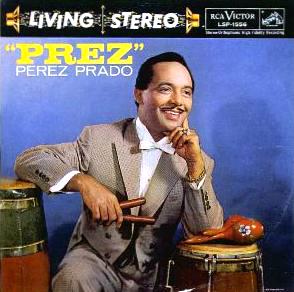Pérez Prado and Mambomania
By Joseph Levy

Though diminutive in stature, Pérez Prado was a giant in the world of post-war popular music. Dubbed "The Mambo King," he reigned supreme as one of the most influential pop orchestra leaders of the early 1950s. As the mambo rhythm spread across the continents, a society emerged from the dark years of World War II to shed it's inhibitions and embrace the frenzy of this Afro-Cuban beat.
Early Years
Dámaso Pérez Prado, El Rey del Mambo, was born in Matanzas, Cuba, on December 11, 1916.[1] His mother was a schoolteacher, his father a newspaper man. In early childhood, he studied classical piano with Rafael Somavilla at the Principal School of Matanzas and as a young man played organ and piano in local cinemas and clubs. He was 26 when he moved to Havana around 1942. There he played piano for the Orquesta del Cabaret Pennsylvania de la Playa de Mariano and soon moved on to a small band at the Cabaret Kursaal. He apparently changed jobs several times in 1942-1943, playing piano for the Orchesta Cubaney and then the Orchesta Paulina Alvarez. He also began to arrange for Gapar Roca de la Peer, some of whose songs were used by the Orquesta Casino de la Playa, the most famous Cuban band of the day. It was directed by Liduvino Pereira and because Cascarita, the lead singer, especially liked these numbers, Prado was hired as pianist and arranger.
Prado's conception of the mambo began to develop in 1943. He later said that four, five, and sometimes six musicians would often play after hours jam sessions on the tres (a small Cuban guitar) and the resultant cross rhythms and syncopation give him the idea. Jazz writer and critic Ralph J. Gleason reported that "Prez" talked to him about the mambo as being an Afro-Cuban rhythm with a dash of American swing. According to Prado, the mambo is "more musical and swingier than the rhumba.[2] It has more beat." He also explained, "I am a collector of cries and noises, elemental ones like seagulls on the shore, winds through the trees, men at work in a foundry. Mambo is a movement back to nature, by means of rhythms based on such cries and noises, and on simple joys."
Origins of the Mambo
The word mambo comes from the Ñañigo dialect spoken in Cuba. It probably has no real meaning, but occurs in the phrase "abrecuto y guiri mambo" ("open your eyes and listen") used to open Cuban song contests. In the Bantu language of West Africa, mambo means "conversation with the gods" and in nearby Haiti, a Mambo is a voodoo priestess.
The mambo as we know it today is actually a rhythm whose tempo may be slow or fast, and almost any standard tune can be set to it's tempo. The saxophone usually sets the rhythm pattern and the brass carries the melody. While Prado is generally credited with popularizing the mambo, its beginnings are often attributed to two other Cubans, Arsenio Rodriguez and Orestes Lopez.
Arsenio Rodriguez (1911-1970), "El Ciego Maravilloso" ("the marvelous blind man"), was a musician of Congo descent who was born in Cuba and was blinded at age twelve by a mule kick. He sang and played bass, percussion, and tres in Havana with various sextets and formed his own extremely popular conjunto [orchestras with eight or more musicisans] in 1940. He is known for spicing up the percussion and brass sections of the son, an earlier Cuban rhythm, and setting the standards for dance bands of the day.
Orestes Lopez played cello for a rival band, La Maravilla del Siglo, which battled Rodriguez in groove-to-groove combat in the recording studio, as well as on stage. Joel Selvin, Pop Music Critic for the San Francisco Chronicle, wrote, "In the '30s, [Orestes and his brother, bassist Israel "Cachao" Lopez] were playing together in a popular but square danzon (dance music) orchestra, Arcano y Sus Maravillas, when Orestes Lopez interrupted the stately procession of the danzon with a dashing, dancing, molten ad-libbed piano solo, as the other band members watched in amazement. Shortly thereafter, in 1939, the brothers formalized the inspired improvisation in a composition they called 'Mambo.'"
Latin percussionist Zeno Okeanos continued, "During the 'mambo' section of this danzon a conga drum was added for the first time to the 'charanga' orchestration. Generally, the term [mambo] seems to connote an 'Africanization' of these other forms by increasing the 'aggressiveness' of the rhythm." However, Cachao pointed out that Prado's mambo was quite different from that of Orestes.
So while it's clear that several rhythms and dances of the period were given the same name, when it comes to the big band mambo that we know today, Prado was most likely the innovator.
1. Prado, himself, claimed to be unsure about his exact date of birth, but apparently was in the habit of shaving five years off his resume, typically giving it as 1921 or 1922.
2. Also spelled "rumba," it is another Cuban rhythm which preceded the mambo.
 |
 |
 |
 |
Main Page |
Site Map & Links |
This Record? |
|---|